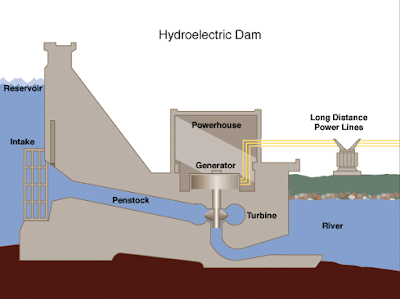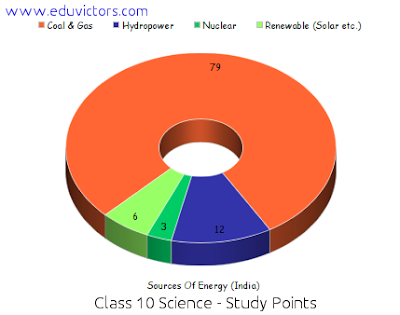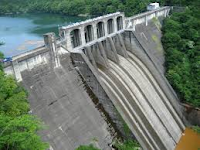Class 10 - Science - Chapter 14
Sources Of Energy
Whenever a body is capable of doing work, the body is said to possess energy. Thus energy is defined as the ability of a body to do work and the amount of energy possessed by a body is equal to the amount of work it can do when its energy is released.
Energy comes in different forms and one form can be converted to another. For example, if we drop a plate from a height, the potential energy of the plate is converted mostly to sound energy when it hits the ground.
A good source of energy should be:
i) Safe and convenient to use, e.g., nuclear energy can be used only by highly trained engineers with the help of nuclear power plants. It cannot be used for our household purposed.
ii) Easy to transport, e.g., coal, petrol, diesel, LPG etc. Have to be transported from the places of their production to the consumers.
iii) Easy to store, e.g., huge storage tanks are required to store petrol, diesel, LPG etc.
Characteristics of good fuel:
(i) High calorific value
(ii) Less smoke
(iii) Less residue after burning
(iv) Easy availability
(v) Inexpensive
(vi) Easy to store and transport
Fossil fuels:
Were formed millions of years ago, when plants and animal remains got buried under the earth and were subjected to high temperature and pressure conditions. E.g.: Coal, Petroleum, etc. These fossil fuels are non-renewable sources of energy and cause environmental problems due to pollution.
Thermal power plants:
(i) Use coal, petroleum and natural gas to produce thermal electricity.
(ii) Electricity transmission is very efficient.
(iii) The steam produced by burning the fossil fuels runs the turbine to produce electricity
 |
| Hydro Power Plant Schematic View Credits: Wikimedia, Tennessee Valley Authority; |
Hydropower plant:
(i) It is the most conventional renewable energy source obtained from water falling from a
great height.
(ii) It is a clean & nonpolluting source of energy.
(iii) Dams are constructed to collect water flowing in high altitude rivers. The stored water has a lot of potential energy.
(iv) When water is allowed to fall from a height, potential energy to kinetic energy, which rotates the turbines to produce electricity.
Disadvantages of Hydropower plant:
(i) Highly expensive to construct.
(ii) Dams cannot be constructed on all river sites.
(iii) Large areas of human habitation and agricultural fields get submerged.
(iv) People face social and environmental problems.
Non-conventional sources
- It is the source of the conventionally used fuels that are used in our country. E.g.: Cow dung cakes, firewood, coal, charcoal.
- Biogas: It is a mixture of gases produced during the decomposition of biomass in the absence of Oxygen. (Anaerobic Respiration). Methane is the major component of biogas.
- Biogas plants: Animal dung, sewage, crop residues, vegetable wastes, poultry droppings, etc. are used to produce Biogas in Biogas plants.
 |
| Wind PowerFarm |
- It can be converted into mechanical and electrical energy.
- The kinetic energy of the wind is used in running of windmills, which are used to lift water, grind grains, etc.
- Advantages:
- (i) Eco-friendly
- (ii) Renewable
- Disadvantages:
- Wind speed is not uniform always.
- Needs a large area to erect series of windmills.
- Big amount of investment is needed.
- The output is less as compared to investment
- Solar radiations can be converted electricity through solar cells (photovoltaic cells).
- Photovoltaic cells convert solar radiations directly into electricity through silicon solar cells.
- Solar cells arrange on a large flat sheets form a solar panel.
- Solar cookers are painted black from outside and a large glass plate to trap solar radiations by the greenhouse effect.
- Advantages of Solar cookers:
- (i) Eco-friendly
- (ii) Renewable
- (iii) Used in rural areas.
- (iv) Retains all the nutrients in food due to slow cooking.
- Disadvantages of solar cooker:
- (i) Silicon cells are expensive.
- (ii) Solar radiations are not uniform over earth’s surface.
- (iii) Cannot be used at night or on cloudy days.
- (iv) Cannot be used to make chapattis for frying as these require a temperature of
- 140°C or more.
- (Maximum temperature of 100°C only can be achieved in a solar cooker)
- Other solar devices- Solar water heater, Solar furnace
- Energy harnessed from the heat of the sun is called Geothermal energy.
- Magma is formed when this heat melts the rocks. The molten rocks and hot gases are called magma.
- The magma gets collected at some depths below the earth’s surfaces. These places are called “Hotspots”
- When underground water comes in contact these hot spots, it changes into steam, which can be used to generate electricity.
- Advantages of Geothermal energy:
- (i) Renewable
- (ii) Inexpensive
- Disadvantages of Geothermal energy:
- Only a few sites available for harnessing energy.
- Expensive
Nuclear Energy
- The energy released when some changes take place in the nucleus of the atom of a substance is called Nuclear energy.
- It is used for heat generation, fuel for marine vessels.
- Advantages or Nuclear Energy:
- (i) An alternative source of energy due to the depletion of fossil fuels.
- (ii) From a small amount of fuel, a large amount of energy is released.
- Disadvantages of Nuclear Energy:
- (i) Risk of nuclear waste leakage
- (ii) The high cost of setting up of nuclear plant
- (iii) Pollution of the environment.
Energy from the Sea
- Tidal Energy: Locations in India – Gulf of Kutch, Gujrat & W. Bengal
- (i) Depends upon harnessing the rise and fall of sea level due to tidal action.
- (ii) Dams are constructed across a narrow part of sea and turbine converts tidal energy into electrical energy.
- Disadvantages: Uniform tidal action is not seen
- Wave Energy:
- (i) The kinetic energy of the waves of the sea is used to rotate turbines.
- (ii) These turbines generate electrical energy




No comments:
Post a Comment
We love to hear your thoughts about this post!
Note: only a member of this blog may post a comment.